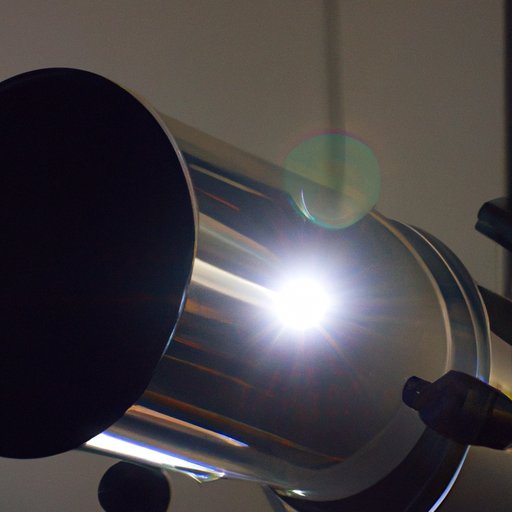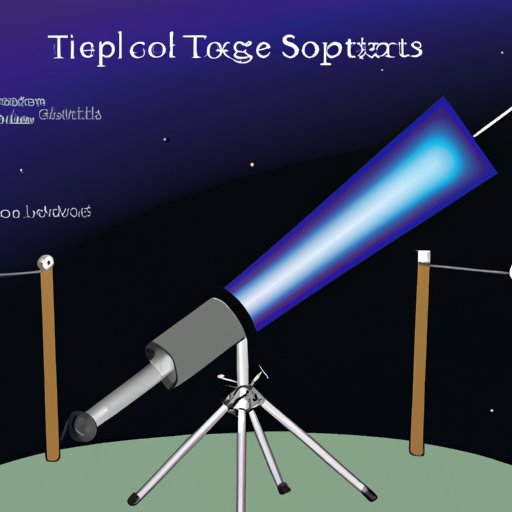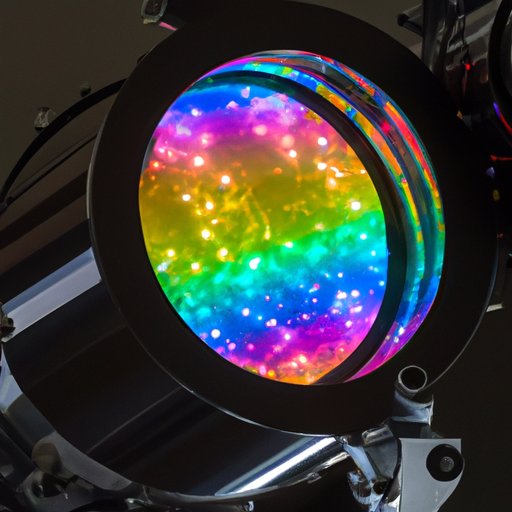Introduction
A telescope is an optical instrument used to observe distant objects by collecting and magnifying light rays. Telescopes are essential tools for scientific exploration, allowing us to see things that would otherwise be invisible to the naked eye. They provide us with a powerful way to study the night sky, revealing objects such as stars, galaxies, comets, and planets that are too far away to be seen without them.
Exploring the Basics of Telescopes: How do They Work?
To understand how a telescope works, it’s important to first understand the basics of light refraction and reflection. Light travels in waves, which can be bent or deflected when passing through certain materials, such as glass or water. This bending of light is known as refraction. Reflection is the bouncing off of light from a surface, such as a mirror. Both of these phenomena play a key role in the way that a telescope works.
The different parts of a telescope also contribute to its function. At the front of the telescope is the objective lens, which collects light from the object being viewed. Behind the objective lens is an eyepiece lens, which magnifies the image. Between the two lenses is a focal plane, where the collected light is focused onto a piece of film or an electronic detector.
The Science Behind Telescopes: How They See What We Can’t
Telescopes capture and magnify light in order to allow us to see things that would otherwise be invisible to the naked eye. With the help of optical lenses, mirrors, and prisms, a telescope can collect and focus light coming from a distant object. This focused light is then directed toward an eyepiece, which magnifies the image so that it can be seen more clearly.
Once the light has been collected and magnified, what does the telescope do with it? The answer depends on the type of telescope being used. Some telescopes have built-in cameras, while others have devices that measure the intensity of the light. By measuring the intensity of the light, astronomers can determine the distance, size, and composition of the object being observed.

How a Telescope Captures and Magnifies Light
Optical lenses are the main components of a telescope. They work by bending light as it passes through them, thus creating an image of the object being viewed. The lenses can be made from different materials, such as glass or plastic, and come in a variety of shapes and sizes. In order for the image to be clear and sharp, the lenses must be perfectly aligned.
Mirrors and prisms can also be used in telescopes. Mirrors reflect light, while prisms split the light into its component colors. By combining different types of lenses, mirrors, and prisms, a telescope can be designed to capture a wide range of wavelengths, from visible light to radio waves.

A Guide to Telescope Types and Their Uses
Telescopes come in many different types, each designed for a specific purpose. Refracting telescopes use lenses to collect and magnify light, while reflecting telescopes use mirrors to do the same. Catadioptric telescopes combine both lenses and mirrors and provide a wider field of view. Each type of telescope has its own advantages and disadvantages, making it suitable for different kinds of observations.
Unpacking the Design and Function of Telescopes
In addition to the lenses and mirrors, there are several other important components of a telescope. Mounts and tripods are used to support the telescope and keep it steady during observation. Eyepieces are used to magnify the image, allowing the viewer to see finer details. Finally, accessories such as cameras and filters can be attached to the telescope to enhance the viewing experience.
Examining the Mechanics of Telescopes
Telescopes are designed to move and point in a variety of directions. This allows them to track and follow objects as they move across the sky. To do this, telescopes use motors, gears, and pulleys to control the movement of the telescope. The power of the telescope’s magnification is also controlled by adjusting the eyepiece and the objective lens.

An Introduction to Telescope Technology and Optics
Modern telescopes use a variety of advanced technologies to improve their performance. Computerized telescopes are equipped with computers that can be programmed to automatically find and track objects in the sky. Adaptive optics systems use special sensors and mirrors to reduce image distortions caused by the Earth’s atmosphere. CCD cameras are used to capture images of faint objects in the night sky.
Conclusion
Telescopes are complex instruments that allow us to explore the universe. By understanding the basics of light refraction and reflection, we can begin to appreciate the science and mechanics behind telescopes. From the various types of telescopes and their uses, to the design and function of telescopes, to the advanced technology and optics used in modern telescopes, this article provides a brief overview of telescope technology and its importance in our world.
(Note: Is this article not meeting your expectations? Do you have knowledge or insights to share? Unlock new opportunities and expand your reach by joining our authors team. Click Registration to join us and share your expertise with our readers.)
